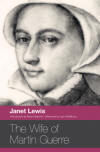The Wife of Martin Guerre
Life choices were nonexistent for Bertrande Guerre (née Rols) in sixteenth century France. Her marriage to Martin was arranged between their wealthy peasant families when they both reached puberty. A distant husband, Martin grudgingly comes to respect Bertrande when she sides with him against his cruel father. To prove her love, she covers for Martin when he runs away. “Eight days” turns into eight years, and Martin returns a changed man . . . that is, if it really is him . . .
Life choices were nonexistent for Bertrande Guerre (née Rols) in sixteenth century France. Her marriage to Martin was arranged between their wealthy peasant families when they both reached puberty. A distant husband, Martin grudgingly comes to respect Bertrande when she sides with him against his cruel father. To prove her love, she covers for Martin when he runs away. “Eight days” turns into eight years, and Martin returns a changed man . . . that is, if it really is him . . .
Janet Lewis based The Wife of Martin Guerre on an actual court case. The questions the sensational trail left unanswered have inspired numerous retellings. The most notable are the 1996 musical by the Les Misérables writing team of Boublil and Schönberg; a 1982 film starring Gérard Depardieu (yes, he was once a genuine leading man) and New Wave muse Nathalie Baye; and Sommersby, the 1993 Jodie Foster and Richard Gere vehicle with the distinction of being one of the most unromantic films ever made. Lewis wrote her vibrant novella in 1941 as the first in her Cases of Circumstantial Evidence trilogy, which Swallow Press has brought back into print. The mystery here is not Martin’s identity, but why Janet Lewis remains obscure.
As the title indicates, Martin is not the main protagonist. Rather, his actions are Bertrande’s life. The girl neglected at her wedding by all but the family dog and servant becomes an intelligent woman with “a manner of gracious command.” During her husband’s prolonged absence, Bertrande changes in another way by gaining a “greater, more mature beauty.” Lewis gives her an inner history neither a transcript nor ledger provides. Her contemporaries Kathleen Winsor (Forever Amber) and Anya Seton (Dragonwyck) did the same admirably in their historical novels but over the course of hundreds of pages, instead of less than 100.
Embellishing the few known facts allows Lewis to tell them within an adventurous narrative. At first Bertrande is pleased when Martin returns. However, his newfound kindness towards family members and tenderness as a lover makes her wonder if she sees “the flesh and bone of Martin Guerre dwelling in the spirit of another man.” The Guerre clan’s reaction is to doubt her sanity. They would rather have this new, improved Martin back in the fold as family patriarch than not have him at all. And if family comes first, the Church is the last word. The parish priest dismisses the “shadow” of her thoughts to “a great change in his spirit;” a miracle best left alone.
The Wife of Martin Guerre is void of grand scale. This matter of public record with the recorded testimony of 150 witnesses retains an intimacy throughout. The author’s final words of judgment are not of sacred or secular law, but a warning that “when hate and love have together exhausted the soul, the body seldom endures for long.” A woman like Madame Guerre who knew and accepted her place deserved better.





